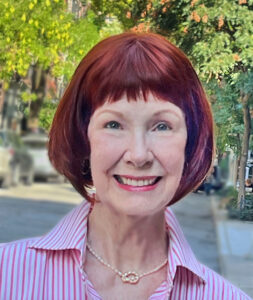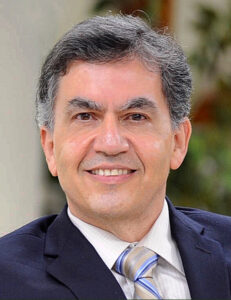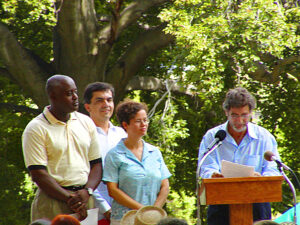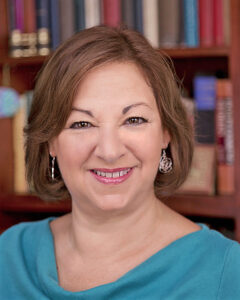Aesthetic Realism Foundation
141 Greene Street
![]() New York, NY 10012
New York, NY 10012
Autumn 2023
Dear Friend,

Margot CarpenterAesthetic Realism Consultant
Executive Director
At this time, when people are more aware than ever that justice is desperately needed in America and the world, I’m proud to be writing to you about the education that can have that justice really be ! It is Aesthetic Realism, founded by the great American philosopher, critic, and poet Eli Siegel. And it is based on this landmark principle: “All beauty is a making one of opposites, and the making one of opposites is what we are going after in ourselves.”

Margot CarpenterAesthetic Realism Consultant
Executive Director
I’m writing to tell you about the work being done by the not-for-profit Aesthetic Realism Foundation. That work, described in our Mission Statement, is cultural, immediate, diverse; it is scientific, and the arts are central to it. It’s the most needed education today.
- How valuable is it that the cause of racism has been explained by Aesthetic Realism — and that the prejudice which plagues our country can finally and truly end through this superb education?
- How much does it matter for men and women to be able to make sense of their lives — increasingly understand themselves, people close to them, people different from them?
- What is it worth that people can learn what beauty is and how art can be immediately, permanently useful to every person’s life?
- What is it worth that a person can feel understood at last?
These are some of the life-changing, life-encouraging benefits of the Aesthetic Realism education. And they each represent the work being done by the Foundation — including through our vital and exciting Outreach Programs.
- How valuable is it that Aesthetic Realism has identified the cause of cruelty and injustice? That cause is the desire for contempt, “the addition to self through the lessening of something else.” Contempt is the source of all racism and economic exploitation. And, yes, contempt in individuals and in nations is the cause of war. Aesthetic Realism — for the first time in history — enables people to understand contempt and effectively oppose it!
Learning about the desire for contempt changes beautifully how a person sees all other people and things. It did for me. I learned that contempt is as everyday as summing a person up or not listening. It has (for instance) a man think he owns a woman, and a woman give herself the right to manage a man. It has a group of children cruelly bully another child via social media “just for fun” — not seeing that this bullied child has feelings as deep as one’s own. All the while, contempt also weakens a person having it, makes him or her feel lonely, unsure, ashamed within.
I have seen, through teaching Aesthetic Realism in consultations, and seen in my own life: when a person learns to criticize his or her contempt, a proud, deep desire to be just comes to be, increases — and wins! Seeing that what we really want is not to lessen other people and things but to find meaning in them — in happenings, objects, art, all people — makes a person kind and intelligent, and glad to be alive!
And I’m very glad to say that Aesthetic Realism consultations are now taking place via internet video-conferencing — as are the unparalleled Aesthetic Realism classes in poetry, anthropology, music, the visual arts, education, marriage, and cinema. So now it is possible for people throughout our nation and beyond to attend them.
Eli Siegel himself exemplified the ethics Aesthetic Realism teaches people today. He was utterly for justice — to every person, every thing. I saw this with my own eyes, as any person who knew Mr. Siegel did. His knowledge was vast; his desire to know was without limit, and so was his kindness.
I’m honored now to study Aesthetic Realism in professional classes for Consultants and Associates, taught magnificently by Ellen Reiss, Chair of Education. Her integrity, knowledge and scholarship, the warmth of her good will, make these classes education of the most exact and highest kind — and an immense pleasure.
From an Aesthetic Realism Public Seminar
And now, I’m joined in this letter by others — through quoting them, and through links to writing of theirs included on the Aesthetic Realism Foundation’s website.

Dr. Jaime Torres
First, there is Dr. Jaime Torres — and a paper of his, presented at an Aesthetic Realism public seminar. The seminar was about a subject that has troubled people tremendously, in every aspect of one’s life, from personal relationships to how a country is run. Dr. Torres’s paper is titled What Mistakes Do Men and Women Make about Coldness and Warmth? It begins:
In the summer of 1967, when I was ten, I heard a man speaking passionately to a large crowd about his plans to bring needed jobs to our town and improve living conditions. As hundreds of people cheered, I was impressed, but what I showed was coldness and indifference as I sulkily complained to my mother, “When are we going home? I’m tired of standing.”
This man was Jaime Torres Rodríguez, my father, who was running for mayor of our town, in Puerto Rico. He hoped to have a good effect on people’s lives. But I thought his concern for the welfare of men and women whom I didn’t even know, was against me. And I made the mistake — which I was to repeat for years — of being more interested in what was coming to me than warmly, respectfully being for what others deserved.
The way I shuttled from warmth to coldness caused me and others confusion and pain. Sometimes I would act as though a person I’d just met was destined to be the best friend I’d ever had. At other times I would avoid someone on the street whom I actually knew quite well. Though outwardly I was affable and easygoing, inwardly I would often seethe with anger. By the age of 15, when my grandfather died, I seemed to feel nothing. At his funeral I cried, not because I felt so much but because I felt too little. “How could I be so cold?” I wondered.
I’m more grateful than I can say that Aesthetic Realism brought kind logic, sanity, to this subject. I learned that the debate we have about the opposites of warmth and coldness is an aspect of a bigger debate raging in everyone about how to see the world: should we see it as something we hope to like and find meaning in, or as something to be aloof from? [Continue reading Dr. Torres’s paper]
Here Is Another Link

Eli Siegel Day Speakers on Racism
Since I’ve just quoted Dr. Torres, and since he is a person who has also spoken importantly on the subject of racism and Aesthetic Realism’s thirsted-for explanation of it, here is another link. It’s to the section, on the Foundation’s website, about a public event in Baltimore on the day that was declared Eli Siegel Day by that city’s mayor and by the governor of Maryland. Speaking on how, through Aesthetic Realism, Racism Can End at last, were (left to right) the late Allan Michael, Dr. Torres, Monique Michael, and Dr. Arnold Perey.
The Aesthetic Realism Teaching Method

Leila Rosen, Educator
Next, joining me in this letter is educator Leila Rosen, through a paper on the Aesthetic Realism Teaching Method. She taught in New York City public schools for 29 years, using that successful, richly logical and compassionate method as her basis. In this paper Ms. Rosen documents, thrillingly, how a class of young people who had had much difficulty reading came really to care for words, to like reading — and to be excited reading a Shakespeare play! Simultaneously, through what they were learning these teens, of different ethnicities, became much kinder to one another. Here is the beginning of her paper given at a public seminar titled The Aesthetic Realism Teaching Method: Students Learn & Prejudice Is Defeated! —Ms. Rosen writes:
It is my fervent hope that teachers throughout America know the Aesthetic Realism Teaching Method. It can end the failure to learn, the pervasive anger, and the prejudice in our nation’s schools. Eli Siegel, whom I see as the most important educator in history, explained that the purpose of education is “to like the world through knowing it.” Many of the young people I have taught have, themselves, endured prejudice and economic injustice. But when students see, through this teaching method, that the English language has a sensible, beautiful structure that stands for the world itself, they learn, and they don’t want to be against people who look and sound different from them. [Continue reading Ms. Rosen’s paper]
A Poem, and People’s Hopes

Rev. Wayne Plumstead
The last person I’ll quote is Wayne Plumstead, United Methodist clergy/pastor (retired) and Aesthetic Realism Consultant. He writes about a poem by Eli Siegel, “Amiable Thoughts for Someone in a Hospital.” This very musical poem has in it some of Aesthetic Realism’s wide, exact, and warm comprehension of a person in a difficult situation. It is a poem that I, too, love. It is included in Eli Siegel’s book Hot Afternoons Have Been in Montana: Poems. Rev. Plumstead writes:
In this poem, which is so profound and kind, Eli Siegel goes deeply within the feelings of a person who is in the hospital and worried about his or her health. The “amiable thoughts” in the poem’s title are the author’s hopes for a man or woman in such a situation. And the word amiable — meaning friendly — is certainly true: what is expressed in the poem is the height of friendliness.
As a pastor who has visited people in hospitals for many years, I have seen the myriad emotions a person can have — including fear about the future, anger at being sick, and, in some instances, deep regret about the past. Here Mr. Siegel gives such kind direction to the thoughts of a person in a hospital, with the hope that these be a source of strength.
“Amiable Thoughts for Someone in a Hospital” meets people at their very center. As I have read the poem with parishioners and we’ve talked about it, without exception they have become more composed and hopeful. I am grateful this poem exists and for the years of deep knowledge and assistance it has provided me in my work as a pastor.
Amiable Thoughts for Someone in a Hospital
A Poem of Aesthetic Realism
By Eli Siegel
May the things you say to yourself
Be the best for you.
May the things you hear from others
Be changed by you,
Be in you,
As the things best for yourself.
May remembrance of the past
Be your friend now.
May thoughts of the future
Be your friend now.
May you see everything you think of
As something which makes you stronger.
May life in bed
Be useful to you
For life everywhere.
May illness be great wellness,
As much as it can be;
And how much illness can be wellness
Has no end;
May be seen any moment;
May be and be.
The Knowledge People Are Looking For
There is certainly much more I could say, and my colleagues can say, about the enormously needed work of the Aesthetic Realism Foundation. You can read more about Aesthetic Realism on our website — including the fact that it explains what love really is — and what in oneself interferes with love. —And as I say that, it is with eternal gratitude for my so happy, ever-deepening marriage to Aesthetic Realism Consultant Robert Murphy.
On the Foundation’s website, you can also read more about the meaning of the historic principle I quoted earlier: “All beauty is a making one of opposites, and the making one of opposites is what we are going after in ourselves.” We want strength and delicacy, logic and feeling, activity and calm, individuality and relation to be at one in us — as they are in a good dance, or poem, or painting, or play, or instance of music.
The knowledge people everywhere are looking for is in the education of Aesthetic Realism. It is the knowledge that can honestly make for peace among the nations of our world.
Sincerely,

Margot Carpenter
Aesthetic Realism Consultant
Executive Director